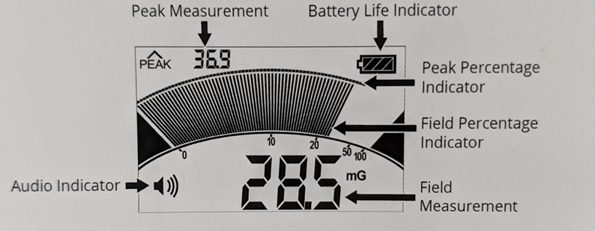How to Take EMF Measurements on the Trifield EMF Meter IC-TF2

The IC-TF2 combines an AC gaussmeter, AC electric field meter, and radio power density meter in a single unit. In addition to standard AC measurement modes, the frequency weighted mode will properly scale the magnetic and electric readings. Incredibly straightforward to use, the Trifield EMF meter can take measurements at a flick of a switch and has all the features needed for fast, accurate measurements of electromagnetic fields.
Figure 1 Watch an Instrument ChoiceScientist take measurements using the Trifield EMF Meter IC-TF2 here.
How to Take EMF Measurements on the Trifield EMF Meter IC-TF2
The IC-TF2 combines an AC gaussmeter, AC electric field meter, and radio power density meter in a single unit. In addition to standard AC measurement modes, the frequency weighted mode will properly scale the magnetic and electric readings. Incredibly straightforward to use, the Trifield EMF meter can take measurements at a flick of a switch and has all the features needed for fast, accurate measurements of electromagnetic fields.
When taking EMF measurements on the IC-TF2, it is essential to know where to find the measurement variables you need on the device’s screen. To assist, we have provided figure 1 (below) and the following notes.
The Field Measurement is the current measured reading. The Peak Measurement captures the highest number and holds it there for 5-seconds or until a higher recording occurs. For measuring general magnetic and electric fields with this EMF meter, the Field Measurement works well. For items such as phones, cell towers, and wifi, which emit in pulses, the Peak Measurement will be more useful.

Figure 1 A labelled diagram of the IC-TF2 LCD screen.
|
IC TIP: When taking electric and radiofrequency field measurements, ensure you hold only the bottom half of the meter. Do not block the top of the meter with your hands. Point the meter outward, away from your body for accurate measurements. |
Magnetic Field Measurement
Use the magnetic field measurement mode for measuring sources of emissions such as powerlines, appliances, wiring in walls, and motors. AC magnetic measurements are made along 3-axis, which produces quick readings, regardless of the orientation of the meter.
Note: a home with low EMF will read less than 3.0 milligauss on standard measurement mode and less than 5.0 milligauss on weighted. To measure magnetic fields:
- Turn the knob to Standard 'MAG' or Weighted 'MAG.'
- Point the meter toward the item or area you wish to obtain a reading.
- As you move towards the source readings will become higher, and as you move away, they will reduce.
Electric Field Measurement
Good targets for electric field measurement include fluorescent lights, wall outlets, wiring, and switches. In an electromagnetically 'quiet' environment, you can expect both standard and weighted measurements to be below 50 V/m. To measure electric fields:
- Turn the knob to standard or weighted 'ELECT.'
- Point the IC-TF2 towards the item or area you wish to measure, remembering to hold the bottom half of the meter and point it away from your body.
- As you move towards the source readings should become higher, and as you move away, they will reduce.
Radiofrequency Measurement
The radiofrequency measurement mode is ideal for measuring items such as phones, WIFI routers, microwaves, radios, and televisions.Transmitting items, such as phones and wifi routers, will emit brief pulses. When measuring these items, read the measurement from the top left' peak measurement' section. A radio 'quiet' area will typically have less than 1.000 milliwatts per square meter as a peak, and field measurement numbers should read less than 0.200 milliwatts.
- Turn the knob to 'RF' to measure radiofrequency.
- Point the meter towards the item or area you wish to measure, remembering to hold the bottom half of the meter and point it away from your body.
- As you move towards the source readings should become higher, and as you move away, they will reduce.
Conclusion
The IC-TF2 if an easy to use all-in-one EMF meter, which can easily measure radiofrequency, as well as standard and weighted electric and magnetic fields.
The exposure levels mentioned in this article are typical readings taken from homes and offices that are relatively low in total electromagnetic fields. Legal maximum exposure limits are significantly higher. View the ICNIRP full guidelines here.
If you would like more information on the IC-TF2 EMF meter or need help finding the best meter for your needs contact an Instrument Choice scientist!
Additional links
- View the IC-TF2 TrifField EMF Meter
- Browse all EMF Meters available at Instrument Choice here.
- Want to see what comes in the box with the IC-TF2? Watch an Instrument Choice Scientist 'Unbox the Trifield EMF Meter IC-TF2'
- Want more information on EMF meters? Read the Instrument Choice articles 'EMF Meters; How to read specifications' and 'What are Electromagnetic Fields, and What are Some Common Sources of EMF?'
Also interesting
The chlorophyll content of a plant is an excellent indicator of its health. The IC-CHLPLS is a powerful, handheld, easy-to-use plant meter for non-invasive measurements of the relative chlorophyll content of green leaf plants. This instrument incorporates a variety of innovative features that makes it suitable for advanced scientific use and research. At the same time, its intelligent design makes it simple to capture accurate relative chlorophyll measurements with the push of a button.

Sling Psychrometers are known for their low-cost, portability, minimal maintenance requirements, and ease-of-use. The IC736700 Sling Psychrometer is no exception. This psychrometer allows users to obtain fast and accurate humidity readings anywhere, without the need for batteries or cumbersome calibrations.This psychrometer comes supplied with an onboard water reservoir and humidity chart, which makes it ideal for indoor and outdoor applications.

